
© Choctaw Nation Photo
Once forcibly removed from their ancestral homelands in the southeastern United States, the Choctaw Nation has transformed adversity into resilience and leadership. After enduring the hardships of the Trail of Tears in the 1830s, the Nation rebuilt its government, culture, and economy in present-day Oklahoma. Today, the Choctaw Nation stands as one of the largest and most progressive federally recognized tribes, known not only for its deep cultural heritage but also for its innovation in areas like health care, education, and emerging technology. Its latest milestone, a state-of-the-art drone facility in rural Oklahoma, highlights the Nation’s continued commitment to sovereignty, sustainability, and forward-thinking development.
The Choctaw Nation’s involvement in drone technology began in 2018, when it was selected as one of ten participants in the Federal Aviation Administration’s (FAA) UAS Integration Pilot Program (IPP). As the only tribal government included, the Choctaw Nation brought a unique combination of sovereign governance and access to expansive rural airspace, ideal conditions for testing advanced drone operations. The Nation focused on key challenges like beyond visual line of sight (BVLOS) flights, emergency response support, and package delivery in remote areas, laying the groundwork for future innovation.
Following the conclusion of the IPP, the Choctaw Nation continued its efforts through the FAA’s BEYOND program, which aimed to more fully integrate drone technology into the national airspace system. These long-term partnerships elevated the Nation’s role as a national leader in aviation research and regulatory collaboration. They also generated direct community benefits, including the creation of more than 30 new jobs across fields such as aviation systems, logistics, engineering, and data management, with expectations for continued job growth as the program expands.
The new facility is called the Emerging Aviation Technology Center and is located in the remote Daisy region of southeastern Oklahoma, nestled within Choctaw-owned tribal lands. The location is significant because its vast, unobstructed airspace, spanning over 44,000 acres, offers an ideal, low-risk environment for testing advanced drone systems.
The Center itself is a three-story building totaling 8,324 square ft, thoughtfully designed to include telemetry and control rooms, maintenance and mechanical workspaces, plus conference, office, and observation areas. Built to support both crewed and uncrewed aerial system innovation, it represents a strategic investment. Though the Choctaw Nation has not publicly disclosed the exact construction cost, it was funded through a combination of federal grants, including a $4 million CARES Act/EDA grant, and tribal allocations to bring this cutting-edge aviation hub to life.
James Grimsley, a seasoned aerospace engineer and industry advocate, serves as the Executive Director of Advanced Technology Initiatives for the Choctaw Nation, where he leads the Nation’s pioneering efforts in drone integration and air mobility. Though not a tribal member, Grimsley became involved with the Choctaw Nation through his deep background in aviation systems and his long-standing commitment to expanding advanced technology infrastructure in rural communities.
Before joining the Nation, he founded an aerospace engineering firm and held key roles in state-level transportation innovation, including serving on the Oklahoma Transportation Commission. Grimsley helped guide the Choctaw Nation’s entry into the FAA’s UAS Integration Pilot Program in 2018 and has since led the development of initiatives like BVLOS drone flights, medical delivery testing, and the design of the Emerging Aviation Technology Center.
Grimsley’s technical expertise and policy engagement, such as participation in the FAA’s BVLOS Aviation Rulemaking Committee, have made him a driving force behind the Choctaw Nation’s ascent as a national leader in unmanned aerial systems. Under Grimsley’s leadership, one of the main focuses of the new center is advancing drone delivery technologies, especially testing BVLOS flights that can transport medical supplies and emergency equipment. “We’re looking at bringing AEDs or being at a house ahead of an ambulance where we get life-saving things, like their medications, equipment, tools,” Grimsley said, “things we need ahead of time.”
These efforts aim to improve healthcare access and emergency response times for remote and rural communities within the Choctaw Nation’s service area, an issue that, as Grimsley points out, has led to loss of life in the past. Ultimately, the new center marks a path to the future for the Choctaw Nation and the United States. The innovations tested there will secure drone applications for everyone living in the country. As Choctaw Nation Chief Gary Batton said, “I think we’re only limited by our imagination on what we can do here.”
|